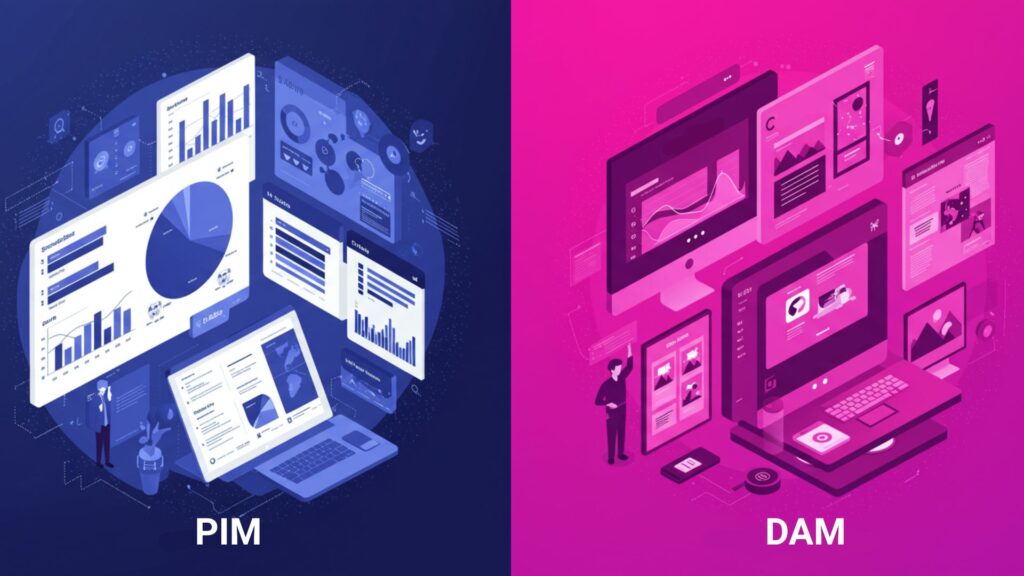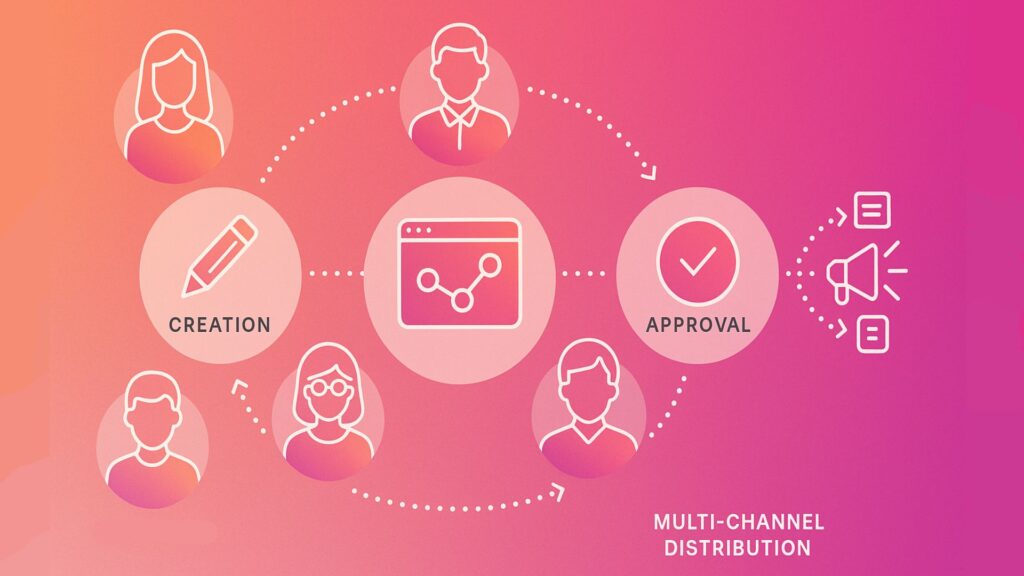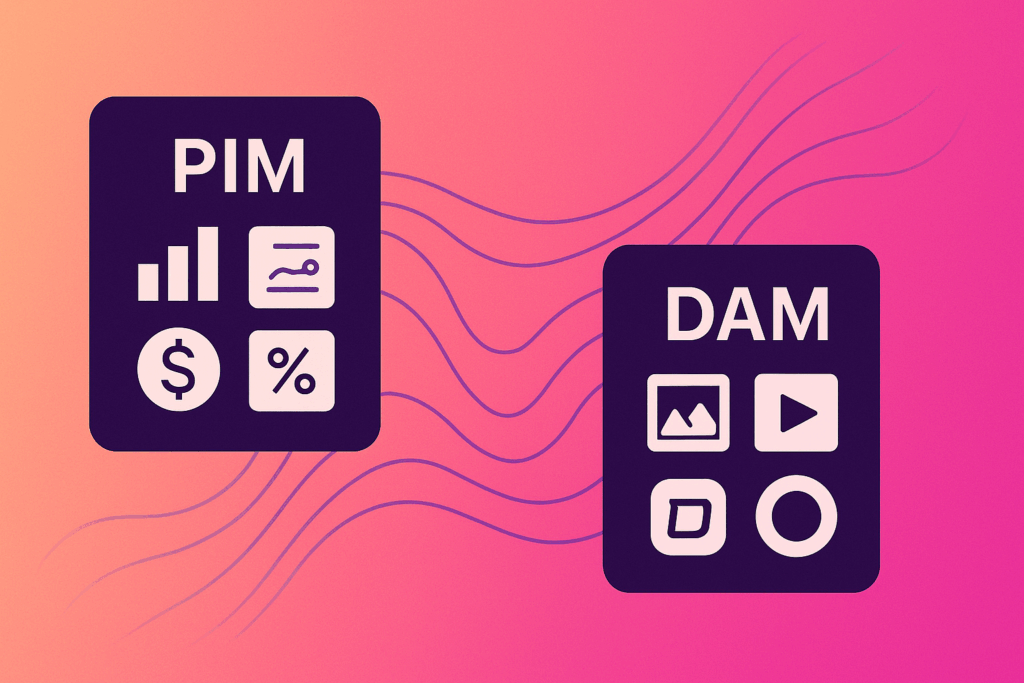PIM and DAM integration creates a powerful foundation for managing product content and brand assets.
- PIM centralizes structured product information, while DAM manages rich media and creative assets.
- Together, they streamline processes and speed up time-to-market.
- Integrated systems make it much easier for teams to find, reuse, and deliver the right assets at the right time.
- Organizations that combine PIM and DAM see stronger brand consistency and higher content performance.
If your business sells products, connecting PIM and DAM is the key to scaling content and staying competitive.
Managing product information gets messier every year. You’re trying to keep thousands of product details accurate and current while also wrangling mountains of images, videos, and marketing materials. The challenge intensifies when this information needs consistent distribution across numerous platforms, including websites, eCommerce marketplaces, and social media channels.
When you’re handling everything manually, things fall through the cracks. You end up with outdated product specs on one channel, wrong images on another, and customers getting mixed messages everywhere they look. Integrating product information management (PIM) and digital asset management (DAM) becomes essential. These systems offer centralized solutions for organizing, streamlining, and distributing both product data and digital content efficiently.
The global DAM market reached $3.96 billion and continues growing at 17% annually, driven by businesses recognizing that scattered content management costs time, money, and competitive advantage. Online retailers and businesses managing large volumes of product data can no longer afford delays or inaccuracies in their content operations.
What Are PIM and DAM Systems?
PIM and DAM solutions are changing the game for how businesses handle digital commerce and product content. They’re not just making things run smoother—they’re actually improving what customers see and experience. Understanding these complementary tools is vital for companies navigating modern content management complexities.
PIM (Product Information Management): Manages your product data, ensuring consistency and accuracy across all sales platforms. It handles specifications, pricing, descriptions, and technical data distribution.
DAM (Digital Asset Management): Organizes and optimizes your brand’s digital assets like images, videos, and marketing materials, enhancing creative workflows and brand consistency.
Together, they create seamless flows of product information and media, elevating customer experience while streamlining operations. Organizations must understand what each system does and how they complement each other to harness their combined power.
What Is Product Information Management?
Product information management is all about wrangling your product data. Think of it as your single source of truth—making sure every product detail stays accurate whether someone’s shopping on your website, a marketplace, or in-store. PIM systems gather critical information like SKUs, product specifications, pricing, and descriptions, then distribute this data across various sales and marketing platforms.
Consider a retailer managing thousands of products across multiple eCommerce sites. A PIM system ensures all product information stays consistent, whether displayed on the company website, major online marketplace, or any other channel. Consistency prevents embarrassing errors like incorrect pricing or outdated product details that can damage customer trust and sales performance.
Today’s PIM platforms handle the complicated stuff really well—like when you’ve got products with multiple variations, seasonal versions, or need to translate everything into different languages.
How Does Digital Asset Management Work?
Digital asset management is your go-to for all the visual stuff—product photos, promotional videos, logos, and basically any marketing material your team creates. DAM systems organize and optimize these assets, making them easily discoverable and usable across teams and channels.
Marketing teams working on campaigns need quick access to the latest product images and promotional videos. A DAM system acts as a central hub where all digital assets are stored, managed, and distributed. It ensures brand consistency across marketing channels while saving creative teams from searching through scattered files across multiple storage locations.
Advanced DAM platforms now include AI-powered features that automatically tag content, suggest optimal crops for different channels, and detect brand compliance issues before assets go live. These AI-driven capabilities, especially in metadata enrichment, workflow automation, and brand governance, are now considered essential selection criteria for DAM platforms.
PIM vs DAM: Key Differences That Matter
Once you understand how PIM and DAM differ (and how they work together), you can actually streamline your operations and keep your brand consistent everywhere customers interact with you.
Product Information vs Brand Assets
PIM and DAM serve different yet complementary purposes in managing business content. PIM focuses on handling structured product information, the go-to system for organizing and distributing product-related data. It ensures accurate, consistent product information reaches various sales and marketing channels, including websites, catalogs, and point-of-sale systems.
DAM manages essential brand assets for maintaining visual consistency. It handles multimedia content often used by marketing teams to create compelling campaigns. DAM ensures these assets are stored, organized, and accessible for marketing, advertising, and communication efforts.

Fashion Retailer Example
For a fashion retailer, this distinction becomes crystal clear. The PIM system stores product-specific details like fabric type, sizing information, care instructions, and pricing for each clothing item. This data is essential for listing products on eCommerce platforms, creating product catalogs, and ensuring accurate information across all sales channels.
The DAM system stores visual elements related to the brand: photoshoots, product videos, lookbooks, logos, and promotional content. These assets are used for marketing campaigns, social media posts, and advertisements, ensuring the brand’s visual identity remains consistent and compelling.
When launching a new line of winter coats, the PIM system ensures each coat’s description, size availability, material details, and pricing are accurately distributed to websites, mobile apps, and retail partners. Meanwhile, the DAM system handles high-quality images from winter coat photoshoots, ensuring consistent visuals across marketing campaigns, social media ads, and store displays.
Operational Efficiency Comparison
| Aspect | PIM Systems | DAM Systems |
| Primary Focus | Product data accuracy | Brand asset organization |
| Efficiency Gains | Centralized data management, reduced manual updates | Quick asset access, streamlined creative workflows |
| User Base | Product managers, merchandisers, sales teams | Marketing teams, creative professionals, brand managers |
| Content Type | Specifications, pricing, descriptions | Images, videos, logos, marketing materials |
| Integration Strength | ERP, eCommerce platforms, marketplaces | Creative tools, CMS, social media platforms |
| Compliance Focus | Product regulations, data accuracy | Brand guidelines, usage rights, legal compliance |
| ROI Metrics | Faster product launches, reduced errors | Improved asset reuse, brand consistency |
Both systems contribute to operational efficiency but in different ways. PIM systems improve efficiency by centralizing and streamlining product data management, ensuring consistent information across sales channels while reducing manual updates and minimizing errors. DAM systems enhance efficiency by providing quick access to organized, approved brand assets, enabling teams to easily locate, distribute, and reuse digital content without duplicating work.
5 Signs You Need Both PIM and DAM
Knowing when to bring PIM and DAM together can be a real turning point—it can completely transform how you manage content and give you an edge over competitors who are still figuring it out.
- Multi-Channel Complexity: You’re selling across 3+ channels and struggling to maintain consistent product information and brand visuals simultaneously.
- Content Creation Bottlenecks: Your team spends more time searching for assets and updating product information than creating new campaigns and driving growth.
- Brand Inconsistency Issues: Different departments are using outdated logos, incorrect product images, or conflicting product specifications across marketing materials.
- Regulatory Compliance Challenges: You need to track product certifications, usage rights, and brand approvals across complex organizational workflows.
- Scalability Constraints: Manual processes prevent you from expanding product lines, entering new markets, or effectively supporting additional sales channels.
2025 Retail Use Cases: PIM and DAM in Action
Retailers are under increasing pressure to deliver personalized, compliant, and efficient shopping experiences across every channel. Integrated PIM and DAM systems give them the tools to meet these demands while keeping operations scalable and brand-consistent.

Omnichannel Seasonal Launches with AI Automation
Global fashion and lifestyle retailers rely on PIM + DAM integration to launch seasonal collections across dozens of markets. AI-powered PIM platforms generate localized product descriptions in multiple languages, while DAM systems automatically crop and reformat images for Instagram, TikTok, and eCommerce product pages. Every channel presents consistent, brand-approved visuals without duplicating creative work.
Sustainability and Compliance Tracking for Food & Beverage
Transparency is now a competitive differentiator. Food and beverage retailers use PIM systems to track certifications like organic, fair trade, and carbon neutral, flagging when updates are needed. Meanwhile, DAM systems manage certification icons, ingredient visuals, and sustainability assets. Together, they ensure marketing claims remain accurate and compliant across product packaging, websites, and digital shelves.
Personalized Shopping Experiences at Scale
Personalization has become a top priority, with 71% of customers expecting it. Retailers are leveraging PIM to store detailed product attributes and customer preference data, while DAM delivers optimized images, videos, and campaign assets tailored to each customer segment. Real-time integration allows AI engines to serve dynamic product recommendations with perfectly matched visuals, driving engagement, loyalty, and conversion. And with the digital content creation market projected to reach $117 billion by 2034, the need for scalable personalization will only intensify.
B2B Manufacturing: Managing Complex Product Catalogs with Precision
Manufacturers often manage tens of thousands of SKUs, each with technical specifications, compatibility requirements, and regulatory data that must be kept accurate across distributor networks. A modern PIM system centralizes this product data, ensuring consistent technical documentation, pricing tiers, and compliance details. Meanwhile, DAM manages installation videos, technical drawings, and multilingual marketing assets.
When integrated, PIM and DAM enable manufacturers to deliver customized digital catalogs for each distributor, complete with accurate specifications and brand-approved visuals. This integration shortens sales cycles, reduces costly errors, and supports global expansion by making it easier to localize content for different regions. With industrial buyers expecting the same seamless digital experiences as consumers, integrated product content management has become a core advantage in B2B manufacturing.
Do I Need Both PIM and DAM?
Here’s the thing: most businesses selling products will benefit from both systems. But there’s no one-size-fits-all approach—your implementation strategy should match what your organization actually needs right now.
Evaluation Criteria for Implementation Priority
Start with PIM if you have:
- Complex product data with multiple variations, specifications, or regulatory requirements
- Frequent pricing changes or product updates across multiple channels
- Compliance-heavy industries requiring detailed product documentation
- B2B sales requiring complex product configurations or technical specifications
- Significant revenue loss from product information errors or inconsistencies
Prioritize DAM when you have:
- Large volumes of visual content across multiple brands or product lines
- Creative teams struggling with asset findability and version control
- Brand consistency issues across marketing channels and campaigns
- Complex usage rights and licensing requirements for visual content
- Marketing campaigns requiring rapid asset deployment across multiple channels
Integration Timeline and ROI Considerations
Companies implementing both systems see faster ROI than those deploying them separately. The optimal approach often involves:
Phase 1 (Months 1–6): Deploy the higher-priority system based on your evaluation criteria, focusing on core workflows and immediate pain points.
Phase 2 (Months 6–12): Begin integration planning while optimizing the first system, identifying connection points and shared workflows.
Phase 3 (Months 12–18): Implement the complementary system with pre-planned integration touchpoints, ensuring seamless data flow between platforms.
Organizations following this staged approach typically achieve faster implementation times and higher user adoption rates compared to simultaneous deployments.
How Does PIM and DAM Integration Transform Business Operations?
When PIM and DAM systems work together, they create centralized hubs for product content management, where product data and digital assets are stored, organized, and easily accessible across entire organizations.

Faster Time-to-Market Through Unified Workflows
Integrated PIM DAM systems accelerate time-to-market by enabling seamless management of both product data and digital assets in streamlined workflows. Combining DAM and PIM improves content accuracy and speed to market, with brands able to deploy product media more quickly and reduce manual asset management. When product information directly links to relevant digital assets, marketing teams can quickly create and deploy product listings across multiple channels.
Integration reduces time spent manually searching for assets or verifying product details, allowing teams to publish accurate, media-rich content faster and more efficiently. By eliminating silos between product and brand data, organizations ensure product launches, updates, and campaigns execute smoothly without delays.
With combined systems, businesses easily manage complex product portfolios, ensuring every piece of content, from product descriptions to high-quality visuals, remains consistent and synchronized across all platforms. This cohesive approach shortens review and approval processes, allowing brands to respond faster to market demands and capitalize on trends without delays.
Consistent Brand Experience Across All Touchpoints
Integration ensures consistent brand experiences by aligning product data with corresponding branded digital assets across all platforms. Organizations can seamlessly connect accurate product information with high-quality visuals, logos, and marketing materials.
Every customer interaction, whether on websites, social media, or retail stores, is backed by up-to-date product details and on-brand media. By maintaining consistency, businesses build stronger brand recognition, reinforce customer trust, and deliver unified experiences aligned with marketing strategies and brand identity.
Enhanced Customer Journey Through Rich Content
Customers expect seamless, engaging experiences across all touchpoints. Integrated PIM DAM systems enhance customer journeys by ensuring every interaction is enriched with accurate, detailed product information and compelling, on-brand visuals.
Customers seamlessly access consistent product descriptions, specifications, and pricing while engaging with high-quality promotional materials. This cohesive experience improves product discovery and decision-making while building trust and reducing friction in buying processes. By delivering the right information and engaging content across every channel, integration creates smoother, more satisfying customer journeys.
Frequently Asked Questions About PIM and DAM
Which should I implement first, PIM or DAM?
The answer depends on your biggest operational pain point. If inaccurate product information is costing sales or creating compliance issues, prioritize PIM. If creative teams spend excessive time searching for assets or brand consistency is suffering, start with DAM. Most successful implementations follow a staged approach, implementing the higher-priority system first, then integrating the complementary solution within 12–18 months.
How do PIM and DAM support retail compliance in 2025?
Modern retail compliance requires tracking product certifications, ingredient sourcing, sustainability metrics, and usage rights across complex supply chains. Integrated systems automate compliance workflows by linking product certifications in PIM with corresponding marketing claims in DAM. When certifications expire or regulations change, automated workflows update both product data and marketing materials simultaneously, preventing costly violations.
How does AI enhance PIM and DAM integration?
AI powers automated metadata generation, intelligent content tagging, and predictive asset recommendations across both systems. Modern platforms use machine learning to automatically categorize products, suggest optimal asset pairings, and flag potential brand or compliance issues before content goes live. This automation reduces manual work while improving content quality and consistency.
Can small businesses benefit from PIM and DAM integration?
Absolutely. While enterprise implementations often grab attention, small and medium businesses often see proportionally higher benefits due to limited resources. Cloud-based solutions make enterprise-grade capabilities accessible to smaller organizations, with many platforms offering scalable pricing based on usage rather than requiring large upfront investments.
Transform Your Content Operations with Strategic Integration
Integrating PIM and DAM systems creates powerful content operations platforms designed to streamline entire content lifecycles, making it easier for businesses to manage digital assets and product information seamlessly.
Advanced AI tools improve asset findability, meaning less time searching and more time creating impactful content. AI capabilities include smart tagging, visual recognition, and enhanced search functions, all aimed at making digital assets easily accessible when teams need them most.
By integrating product content management solutions, businesses ensure product data and digital assets work in harmony. Integration improves brand consistency and accelerates time-to-market, allowing companies to deliver superior customer experiences across all touchpoints.
The companies crushing it with content operations aren’t just using fancy file storage. They’re using platforms actually built for managing content—systems that understand workflows, not just folders. This approach positions organizations to leverage emerging innovations like intelligent content tagging, predictive asset recommendations, and automated compliance checking.Aprimo’s AI-powered content operations platforms support PIM + DAM integration, providing centralized hubs for all content needs. Whether updating product information or distributing brand assets, integrated solutions ensure everything remains aligned, current, and optimized for performance. Get started with a demo to see how strategic integration can transform your content operations and accelerate business growth.


